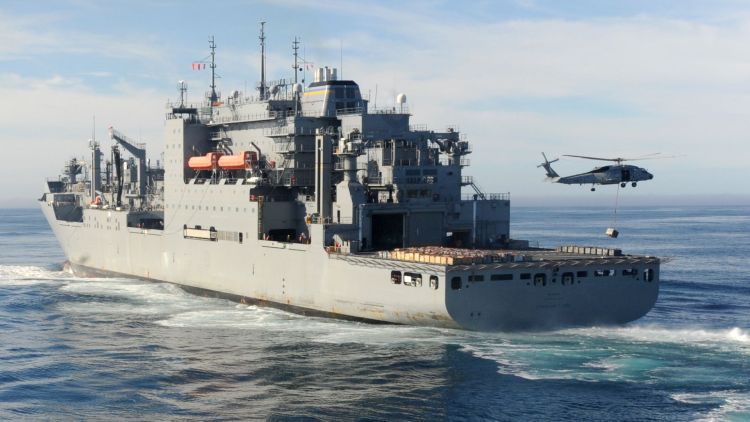The US Navy is facing a challenge that has nothing to do with enemy fleets or foreign threats—it’s a crisis from within.
We’re talking about a severe shortage of qualified civilian mariners, and it’s gotten so bad that the Navy is planning to sideline 17 key support ships.
These aren’t just any vessels; we’re talking about ships that have played crucial roles in our global operations.
Now, this isn’t just a short-term issue. It’s a symptom of something deeper—caused by years of neglect and poor management of our civilian workforce.
These men and women are the backbone of our fleet, and if we don’t take care of them, the whole system starts to wobble.
By putting these ships into “extended maintenance,” the Navy is running a big risk, and here’s why we think this is the case.
It’s more than just about docking and mooring a few boats; it’s about weakening our logistical muscle and our ability to keep a strong presence around the world.
Bottom line: we’re seeing the real cost of overlooking the very people who keep our Navy mission-ready.
The Human Impact: Strained Workforce
In a report by USNI News published on Thursday, August 22, they highlighted that at the heart of this crisis is the unsustainable work-life balance faced by the Navy’s civilian mariners.
These individuals, who crew the Navy’s logistics ships, are the backbone of the fleet, ensuring that vessels around the world are refueled, resupplied, and ready for action. However, the demands placed on them have become increasingly untenable.
For every position on a Military Sealift Command (MCS) ship, there are roughly 1.27 mariners available to fill the role—a ratio that former MSC master mariners describe as unsustainable.
This means that mariners are often at sea for four months, with only a month on shore before being redeployed. Such a grueling schedule leaves little room for rest, family time, or attending to personal needs.
The result is a workforce that is burned out, overworked, and rapidly shrinking.
Navy civilian personnel offload a vertical-launch missile canister from a barge during ordnance operations. (DVIDS)
The COVID-19 pandemic exacerbated these issues.
Strict “gangway up” measures were implemented to prevent the spread of the virus, but they also prevented mariners from leaving their ships, sometimes for months on end.
Morale plummeted, and many mariners chose to leave the service altogether, citing the poor work-life balance and the toll it was taking on their personal lives.
One retired MSC mariner shared with USNI News that he left not because of the work itself but because he didn’t want to suffer the same fate as older colleagues who faced divorce and estrangement from their families.
The Strategic Risks: Sidelining Key Vessels
In response to this workforce crisis, the Navy has reportedly proposed the “force generation reset” plan, which involves sidelining 17 support ships to free up mariners for other vessels.
Among the ships affected are two Lewis and Clark replenishment ships, one fleet oiler, 12 Spearhead-class Expeditionary Fast Transports (EPFs), and two forward-deployed Navy expeditionary sea bases. These ships have played crucial roles in supporting US military operations around the globe.
According to reports, the USS Lewis Puller (ESB-3), for example, has been stationed in Bahrain since 2017, serving as a key platform for mine countermeasures and special operations in the region. It has been involved in critical missions, including anti-smuggling operations targeting Iranian weapons shipments.
USS Lewis B. Puller (ESB 3), left, and USS Paul Hamilton (DDG 60), right, patrol the Arabian Gulf, March 25, 2020. (DVIDS)
Similarly, the USS Herschel “Woody” Williams (ESB-4) has been central to the Navy’s efforts in Africa and Europe.
Sidelining these vessels could create operational gaps, particularly in volatile regions where American forces’ presence is crucial.
The EPFs, high-speed aluminum catamarans used for outreach missions in the Pacific, Europe, and Africa, are also on the chopping block.
Despite their relatively young service life, these ships are being sidelined far earlier than expected, a decision driven purely by the shortage of mariners.
The long-term strategic consequences of these decisions are profound. By sidelining these ships, the Navy risks weakening its logistical capabilities, making it harder to sustain operations in key regions.
This move could also send a message to adversaries that the US Navy’s operational readiness is compromised—a dangerous signal in an increasingly volatile world.
The Root Causes: Years of Neglect and Mismanagement
How did the Navy arrive at this point?
Apparently, the answer lies in years of neglect and mismanagement of the civilian mariner workforce.
The Navy has failed to adequately manage and support its mariners, creating a cycle of burnout and attrition that has now reached a crisis point.
Sustainable Work-Life Balance
For years, the Navy’s approach to managing civilian mariners has been to demand more with less without providing the necessary support to ensure a sustainable work-life balance.
Training requirements have increased, yet the time allotted for rest and recuperation has not kept pace.
The result is a workforce that is stretched thin, with many mariners leaving the service out of necessity rather than choice.
Lack of Investment
Compounding these issues is the Navy’s lack of investment in workforce development.
Recruitment efforts have lagged, and there has been little focus on retaining experienced mariners. This has led to a shrinking pool of qualified personnel, forcing the Navy to consider drastic measures like the force generation reset.
An MH-60S Sea Hawk conducts a vertical replenishment with the MSC fleet replenishment oiler USNS Laramie (T-AO 203), September 22, 2008. (DVIDS)
Versus Commercial Maritime
Commercial maritime practices offer a stark contrast.
In the commercial sector, mariners often work under union contracts that provide for a healthier work-life balance, with more time off to recover between deployments.
The Navy, by comparison, has been slower to adopt such practices, leaving its civilian mariners at a disadvantage.
Two Cents Moving Forward
The current situation just isn’t working, and the Navy needs to take real steps to fix the underlying causes of this workforce shortage.
Our two cents: making work-life balance better for civilian mariners should be at the top of the list.
A better balance could mean increasing the mariner-to-billet ratio, giving more time for rest, and tweaking leave policies to fit the tough demands of the job.
As we’ve mentioned before, investing in workforce development is key.
The Navy needs to step up efforts in recruiting and retaining a solid civilian mariner workforce, with incentives that make the career more appealing. This could involve better training options, competitive pay, and clear career paths for those who want to move up.
Finally, the Navy must rethink its approach to fleet management.
Instead of sidelining key ships, they should look for other ways to keep these vessels running while dealing with the workforce shortage. This could mean shifting mariners from less critical roles or even exploring new tech that can cut down on the manpower needed to operate these ships.
Fleet Readiness Center East (FRCE) SkillBridge interns inspect wiring on a V-22 Osprey, September 11, 2023. (DVIDS)
Finals Thoughts
The bottom line is that sidelining 17 Navy support ships because of a shortage of civilian mariners is a glaring example of how neglect and mismanagement catch up with you.
Right now, the Navy’s priority is easing the pressure on its workforce, but the bigger picture shows this decision could have serious long-term effects.
To avoid bigger problems down the road, the Navy needs to tackle the root causes of this shortage and implement real reforms. Only then can we keep our logistical strength intact and continue projecting power around the world.
It’s time to act—before the costs get even steeper.
—
Disclaimer: SOFREP utilizes AI for image generation and article research. Occasionally, it’s like handing a chimpanzee the keys to your liquor cabinet. It’s not always perfect and if a mistake is made, we own up to it full stop. In a world where information comes at us in tidal waves, it is an important tool that helps us sift through the brass for live rounds.



